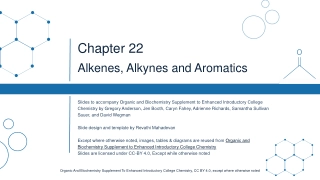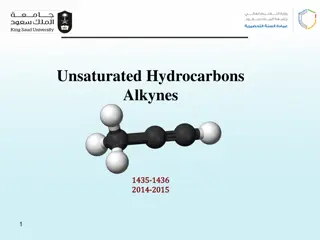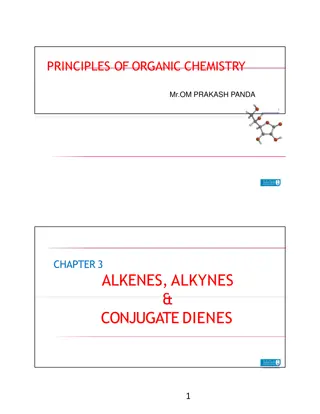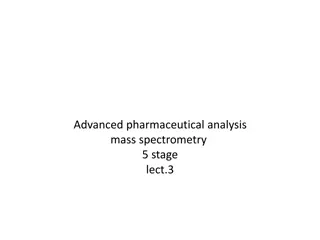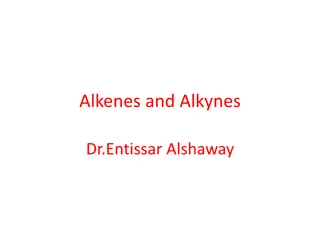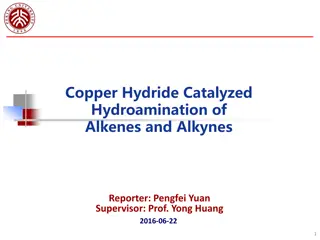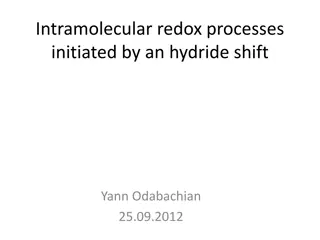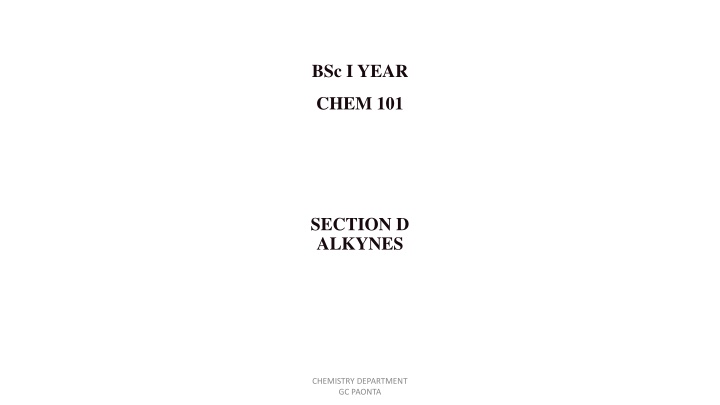
Alkynes Chemistry: Methods, Preparation, Reactions & Synthesis
Explore the world of alkynes in chemistry with details on their methods of preparation, reactions, synthesis, and more. Learn about the formation of alkyl and heavy metal acetylides, dehydrohalogenation, and the synthesis of higher alkynes from acetylene.
Download Presentation

Please find below an Image/Link to download the presentation.
The content on the website is provided AS IS for your information and personal use only. It may not be sold, licensed, or shared on other websites without obtaining consent from the author. If you encounter any issues during the download, it is possible that the publisher has removed the file from their server.
You are allowed to download the files provided on this website for personal or commercial use, subject to the condition that they are used lawfully. All files are the property of their respective owners.
The content on the website is provided AS IS for your information and personal use only. It may not be sold, licensed, or shared on other websites without obtaining consent from the author.
E N D
Presentation Transcript
BSc I YEAR CHEM 101 SECTION D ALKYNES CHEMISTRY DEPARTMENT GC PAONTA
ALKYNES Acyclic unsaturated hydrocarbons containing a triple bond are called alkynes or acetylenes. Their general fommla is CnH 2 n _ 2 where n = 2, 3, 4 ... ... etc . Common names In the common system, the first member of the series is called acetylene. IUPAC names. Alkane-ane + yne = Alkyne. CHEMISTRY DEPARTMENT GC PAONTA
METHODS OF PREPARATION OF ALKYNES 1. By the action of water on calcium carbide Ethyne (acetylene) is prepared in the laboratory as well as on a commercial scale by the action of water on calcium carbide. CHEMISTRY DEPARTMENT GC PAONTA
ALKYNES . Synthesis of higher alkynes from acetylene. Acetylene is first treated with sodium metal at 475 K or with sodamide in liquid ammonia at 196 K to form sodium acetylide. This upon treatment with primary alkyl halides undergoes Si reaction to give higher alkynes. For example CHEMISTRY DEPARTMENT GC PAONTA
LOWER TO HIGHER ALKYNES CHEMISTRY DEPARTMENT GC PAONTA
By dehydrohalogenation of dihaloalkanes. . Alkynes are prepared by dehydrohalogenation of vicinal-dihaloalkanes on heating them with an alcoholic solution of potassium hydroxide. CHEMISTRY DEPARTMENT GC PAONTA
DEHYDROHALOGENATION CHEMISTRY DEPARTMENT GC PAONTA
CHEMICAL REACTION OF ALKYNES . Formation of alkali metal acetylides. Ethyne and other terminal alkynes (or 1-alkynes) react with strong bases such as sodium metal at 475 K or sodamide in liquid ammonia at 196 K to form sodium acetylides with evolution of H2 or NH3 gas CHEMISTRY DEPARTMENT GC PAONTA
. Formation of heavy metal acetylides Acetylenic hydrogens of alkynes can also be replaced by heavy metal ions such as Ag+ and Cu+ ions. For example, when treated with arnmoniacal silver nitrate solution (Tollens reagent), alkynes form white precipitate of silver acetylides. CHEMISTRY DEPARTMENT GC PAONTA
Heavy metal acetylide CHEMISTRY DEPARTMENT GC PAONTA
HEAVY METAL ACETYLIDE CHEMISTRY DEPARTMENT GC PAONTA

